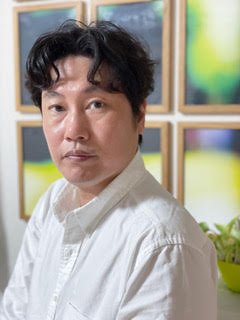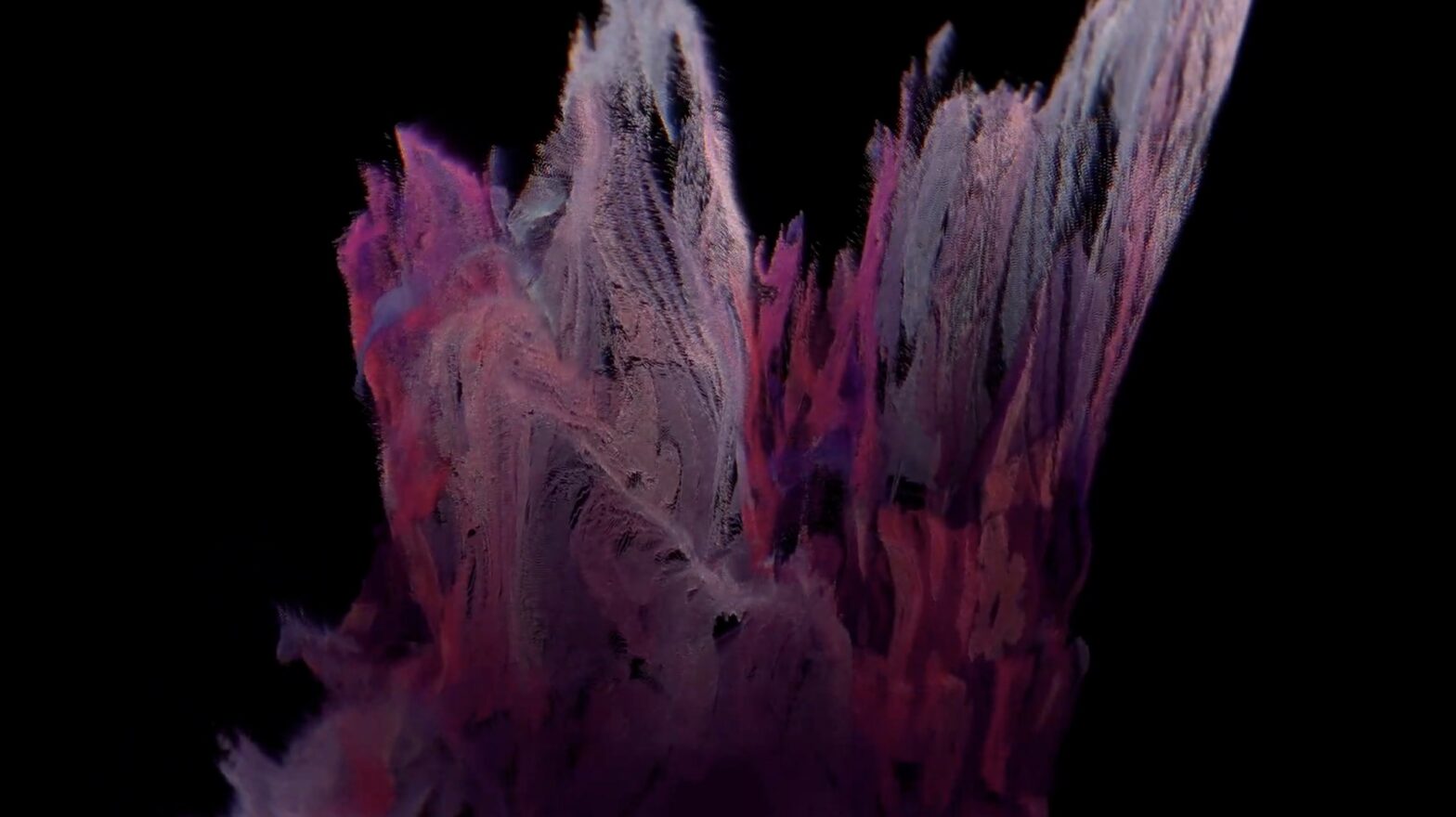Niio Editorial

Born in Osaka in 1976 and trained in post-production editing after graduating from the University of Fine Arts, Eisuke Ikeda has developed a distinctive visual language that seamlessly weaves analog sensibility into digital precision. His works are marked by an intentional embrace of imperfection—subtle distortions, organic pulses, and delicate fractures that bring a surprising tactility to the virtual screen. Central to Ikeda’s practice is a deep trust in the viewer’s intuition. He eschews overt symbolism or narrative structure, focusing instead on the phenomenological act of seeing. Subtle distortions, organic fluctuations, and textural echoes mimic natural erosion and evoke the tactile essence of physical matter, despite being rendered entirely in the digital realm.
Niio has recently launched the solo artcast Eternity of the Ephemeral, which features five artworks that, more than just moving images, unfold like ambient states of consciousness. These are not works to be watched in the conventional sense—they are to be dwelled in, felt, and absorbed. Each composition becomes an experiential landscape where the viewer’s perception becomes the true medium. In the following interview, the artist elaborates on his creative process and the concepts that underlie his artistic practice.
Eisuke Ikeda. EXoC 2681257 | 2025 Remix |, 2025
You have worked as a post-production CGI specialist for film productions. How does this background influence or nurture your artistic production? What have you learned in terms of software usage and image production that you are now applying to your artistic projects?
When I worked in post-production, my duties ranged from assisting with television editing to creating CGI components and producing opening visuals for music events.
What impressed me most during that time were the veteran craftsmen at the Kyoto film studios. Cinematographers, editors and script supervisors—professionals who, in other careers, would already be retired—devoted themselves to finishing each project, working through the night without hesitation. Their approach to filmmaking was more than technical skill; it was a way of life. The blend of boldness, precision and pride they embodied remains vivid in my memory.
Those experiences still shape my practice today. Although my methods have evolved, the resolve to “communicate through moving images” and the quiet sincerity with which I face each work are values I inherited from them.
“The interweaving of nature with daily life and the presence of temples and shrines in Kyoto have formed my aesthetic foundation since childhood.”
My sensibility is also rooted in Kyoto’s environment. The interweaving of nature with daily life and the presence of temples and shrines have formed my aesthetic foundation since childhood. From art-school days to the present I have been drawn to contemporary art, Japanese Zen, Buddhist art and classical arts; the decorative and symbolic qualities of hanging scrolls, folding screens and esoteric Buddhist implements continue to influence me spiritually.
The software skills I acquired by self-study at university became my technical base. I entered the field just as digital tools were being introduced, and programs such as After Effects, Photoshop and non-linear editors proved indispensable in both commercial and personal work. Those skills still underpin my art today. More recently I have expanded my toolkit—again self-taught—to include TouchDesigner and Ableton Live.
Thus, beyond any single CGI technique, it is the mindset and sensibility cultivated in post-production, together with my exposure to diverse art forms, that define the core of my creative work.
Eisuke Ikeda. EXoC 2681257 | 2025 Remix |, 2025
Can you briefly describe the process of elaboration of your artworks? Despite being abstract compositions, what are the experiences, images, or ideas that trigger their creation?
I currently rely on TouchDesigner and Ableton Live to pursue abstractions in which sight and sound intertwine. Although I once produced 3-D character animation, I gradually became more attracted to abstraction—forms that leave interpretation to the viewer rather than imposing narrative or figuration. I am drawn to structures with no beginning or end, no fixed centre, in which spiritual resonance can reside.
My process is improvisational. Instead of following a strict concept, I trust “moments of visual delight.” As light, motion and colour shift, I adjust elements in real time, responding with my emotions and bodily sense—an approach akin to musical improvisation.
The five works uploaded to Niio focus on delicate particle movements, yet my style remains fluid. Depending on my state of mind I may move toward flat compositions, high contrast or rapid motion. In every case I seek to evoke pre-linguistic emotions or fragments of memory, rather than convey explicit meaning.
“I am drawn to structures with no beginning or end, no fixed centre, in which spiritual resonance can reside.”
In your artworks, you avoid any rigid interpretation or meaning. In fact, the title of each video is mostly a reference number, with no intention of providing any narrative. Yet the descriptions are quite poetic, with references to memory, silence, the soul, or eternity. How do you balance the purely abstract and rational with the more evocative and narrative aspects of your work?
Titles such as EXoC or abCnW are deliberately cryptic: abbreviations of words that interested me at the time. They preserve ambiguity and poetic space, encouraging open interpretation rather than prescribing it.
Ultimately I want to offer a “purely visual experience” that quietly expands awareness. What I call a “tactile sensation beyond the screen” is this spiritual and sensory resonance—one that connects, for me, with the animistic quietude in traditional Japanese aesthetics.
“Ultimately I want to offer a purely visual experience that quietly expands awareness.”
Ephemerality is a key concept in your work, expressed in fleeting elements, bursts of light, and also darkness. Is the search for the expression of the ephemeral what led you to work with digital media? How do motion, light, and darkness play a role in your work?
Creating art has always been a digital act for me. Since my student days I have worked on a computer; I have never painted on canvas. Thus expression and digital media are inseparable in my practice.
I did not adopt digital tools because I sought ephemerality; rather, I have long explored how to express ephemerality within the digital environment I know so well.
That sense of impermanence appears in flickers of light, bleeding shadows and formless tremors that rise and vanish. These overlap with memory fragments and emotional echoes, permeating the viewer as a subtle perception of time and space.
Motion, light and darkness are indispensable to this. They remain understated—quivering softly inside the frame, leaving a quiet trace. Only digital media allow the fine-grained accumulation of change that produces the fragile texture I seek.
Eisuke Ikeda. EXoC 2681257 | 2025 Remix |, 2025
Each artwork in this series features a meditative soundtrack. How does music support the visual experience? Does it introduce a narrative, or convey a certain emotion?
For every piece in this series the soundtrack was composed after the visuals were completed. The music introduces no explicit narrative; its purpose is to support atmosphere and mood.
Sound and image function symbiotically: audio flows with the rhythm of light and movement. Rather than directing viewers toward set emotions, the restrained soundscape leaves room for personal reflection and sensory introspection.
“Only digital media allow the fine-grained accumulation of change that produces the fragile texture I seek.”
The use of Artificial Intelligence models is gaining widespread use in artistic creation. Are you interested in applying AI to your creative process in any way?
Advances in AI have opened a new perspective on my work. When OpenAI’s ChatGPT gained wide attention a few years ago, its potential struck me powerfully. For an artist rooted in digital expression, AI’s arrival echoed the shock photography once delivered to painting, prompting artists to reconsider their medium.
Many creators now collaborate with AI. I have begun tentative experiments in TouchDesigner, exploring AI-driven possibilities. My use is still preliminary, but I am gradually looking toward deeper integration—generating code and widening the scope of interaction.

